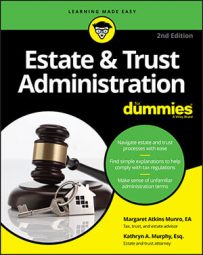In addition to allowing you to split each income distribution into all its component parts, Schedule K-1 also gives the estate income beneficiary all the other tax attributes that can pass through the trust or estate to the beneficiary.
Deductions
Except for in the last year of an estate or trust, a Schedule K-1 rarely shows any deductions that the beneficiary can use on his or her tax return. Deductions are the payments the trust or estate makes that reduce its taxable income. Still, it can happen, so here are a few you may see:
Directly apportioned deductions: If the trust or estate is passing out any of the following deductions, place these numbers on line 9:
Depreciation: Deducting a portion of an asset’s acquisition cost annually over the period of its useful life.
Depletion: Deducting the reduction in value of an asset as that asset is used up.
Amortization: Reducing the cost of an intangible asset over its projected life.
These calculations can be tricky, and you may want to seek a pro’s help here.
Estate tax deduction: If estate tax has already been paid on a portion of the income earned by the trust or estate, you’re entitled to an income tax deduction equal to the estate taxes paid on that income. Place each beneficiary’s share of an estate tax deduction on Schedule K-1, line 10.
For example, say the Whipple Estate, which paid an estate tax at the top tax rate of 40 percent, included a retirement account on which no income taxes had ever been paid. Every year, it receives $10,000 from that retirement account that is subject to income tax. The estate tax on each distribution is $4,000 ($10,000 × 40 percent).
Assuming that the eventual recipient of the annual distributions is also taxed in a high bracket, the potential income tax on each distribution could be an additional $3,960, making $7,960 in total tax, or 79.6 percent. However, the estate receives an estate tax deduction of $4,000, which may be passed out to an income beneficiary.
Even if the beneficiary is in a high bracket, the amount of that distribution subject to income tax reduces to $6,000 ($10,000 distribution – $4,000 estate tax deduction). A 39.6-percent-bracket taxpayer then only pays $2,376 in income tax on that distribution, or $6,376 in total tax, reducing the tax rate to a nominal 63.76 percent. The estate tax deduction doesn’t provide a huge benefit, but it’s better than nothing.
Final-year deductions: Often, you wrap up an estate or trust in a flurry of activity accompanied by an avalanche of final fees without much in the way of income to offset them. If you have more fees than income in the final year of a trust or estate, you may give them to the beneficiaries on line 11 of Schedule K-1.
Short- or long-term capital loss carryovers also belong here, as well as net operating loss carryovers, calculated both for regular tax computations and for the alternative minimum tax.
Credits
Credits, those dollar-for-dollar offsets against tax that are so valuable to taxpayers, don’t appear frequently on Schedule K-1. But that doesn’t mean they’re not available. The back of Schedule K-1 has a list of credits a trust or estate may pass through to its income beneficiaries — you may marvel at the number, even as you wonder how a trust could ever generate an orphan drug credit.
Here are the two most common:
Credit for estimated taxes: If you made the election (you know because you already checked Part I, Box D), place this beneficiary’s share of estimated taxes on line 13.
Credit for backup withholding: A beneficiary sometimes gets into trouble with the IRS for failing to pay his or her taxes. If that happens, you’ll receive a letter from the IRS instructing you to withhold income taxes on any distributions to that beneficiary. If the trust or estate must withhold on distributions, place the amount that you withheld and sent to the IRS on line 13.

